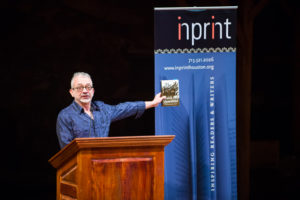 In his reading at the UH Moore’s Opera House last night, Michael Ondaatje deftly collaged a variety of scenes and moments from his most recent novel,The Cat’s Table, to take us on a voyage across the oceans, through time and space. Before reading, Ondaatje addressed the question of the mix of autobiography and fiction in the book. While both he and the main character (also named Michael) took a journey on a boat called the Oronsay from Ceylon/Sri Lanka to England in the fifties when they were both 11 years old, he mentioned that in fact all he remembered of the voyage was the ping-pong table on the ship. Paradoxically, for him, this lack of memory freed him up to invent a new story, to create something more wild, more meaningful and more thrilling than reality could ever possibly have been. As he said, quoting Ornette Coleman about music, “What you begin with is the territory, what follows is the adventure.”
In his reading at the UH Moore’s Opera House last night, Michael Ondaatje deftly collaged a variety of scenes and moments from his most recent novel,The Cat’s Table, to take us on a voyage across the oceans, through time and space. Before reading, Ondaatje addressed the question of the mix of autobiography and fiction in the book. While both he and the main character (also named Michael) took a journey on a boat called the Oronsay from Ceylon/Sri Lanka to England in the fifties when they were both 11 years old, he mentioned that in fact all he remembered of the voyage was the ping-pong table on the ship. Paradoxically, for him, this lack of memory freed him up to invent a new story, to create something more wild, more meaningful and more thrilling than reality could ever possibly have been. As he said, quoting Ornette Coleman about music, “What you begin with is the territory, what follows is the adventure.”
And adventure we did, as he began with the boys’ youthful highjinks on board then lead into a description of a proper Sri Lankan man, Dr. Fonseca, on his way to England. Ondaatje described him as “tentative and languid” with “a serenity that came with the choice of the life he wanted to live”—this serenity that the narrator had seen “only among those who have the armour of books close by” (and I couldn’t help but see a bit of the author himself here). Then Ondaatje skillfully took us to the deck of the ship during a storm, through the Suez Canal and then on to London years later as he attempts to reconnect with Cassius, one of his co-conspirators on the Oronsay. Ondaatje’s voice was surprisingly soft and gentle, a soothing monotone with clipped consonants and rapid flow. His tale was ethereal, carefully paced and surprisingly comforting. It turns out that Ondaatje’s focus in The Cat’s Table is not only crossing from Ceylon/Sri Lanka to London, but also traversing the smaller lines drawn across the ship itself, like the border he mentioned between the First Class and Tourist Class or like the silences between the characters themselves.
In the question and answer section with writer and UH professor Chitra Divakaruni, Ondaatje alternated between serious reflections on writing and quite funny anecdotes. A question from Divakaruni about the melding of non-fiction and fiction yielded the funniest one-liner of the night, as Ondaatje quoted famed Texas gadabout Kinky Friedman saying, “There’s a fine line between fiction and non-fiction, and I think I snorted it in 1976.”
On a more serious note, he also declared that, beyond jazz, the greatest artistic invention of the twentieth century was the collage. Its impact, he said has been felt across the arts from film to painting, from literature to music, and he spoke insightfully about his own process of writing his first book The Collected Works of Billy the Kid as a collagist approach. First, he wrote fifty poems, then the prose pieces and finally worked to collage them all together, creating connections between the different texts on the page, adding photographs and writing fake interviews with Billy himself. He contrasted that collagist writing with his more recent approach to The Cat’s Table, which, despite its chronological ebb and flow, was largely written straight from the beginning to the end.
There’s an evocative line in The Cat’s Table that seemed to sum up the evening for me: “We came to understand … our lives could be large with interesting strangers who could pass us without any personal involvement.” Hopefully, you had a chance to witness this particular interesting stranger last night. And if not, the armor of his books are a wonderful substitute.
 It is even more impressive when that said writer is able to breathe new life into a centuries old epic and turn that seemingly archaic story into a captivating novel. In The Forest of Enchantments, Houston author and American Book Award winner Chitra Divakaruni accomplishes this and so much more.
It is even more impressive when that said writer is able to breathe new life into a centuries old epic and turn that seemingly archaic story into a captivating novel. In The Forest of Enchantments, Houston author and American Book Award winner Chitra Divakaruni accomplishes this and so much more.

 On November 21st, the Alley Theatre was already decked for the holidays. A grove of themed trees in the lobby welcomed the
On November 21st, the Alley Theatre was already decked for the holidays. A grove of themed trees in the lobby welcomed the  Aja Gabel, University of Houston Creative Program PhD, Class of 2015, has sold her first novel, In Common Time, to Riverhead Books, where it will be published next year. We caught up with Aja in the calm before the storm of her literary debut. Some of you may know Aja as the recipient of the Inprint C. Glenn Cambor/Fondren Foundaiton Fellowship, winner of an Inprint Donald Barthelme Prize in Nonfiction, and winner of an Inprint Alexander Prize in Fiction. Aja also taught writing workshops for Inprint and was one of Inprint’s beloved live tweeters.
Aja Gabel, University of Houston Creative Program PhD, Class of 2015, has sold her first novel, In Common Time, to Riverhead Books, where it will be published next year. We caught up with Aja in the calm before the storm of her literary debut. Some of you may know Aja as the recipient of the Inprint C. Glenn Cambor/Fondren Foundaiton Fellowship, winner of an Inprint Donald Barthelme Prize in Nonfiction, and winner of an Inprint Alexander Prize in Fiction. Aja also taught writing workshops for Inprint and was one of Inprint’s beloved live tweeters.
